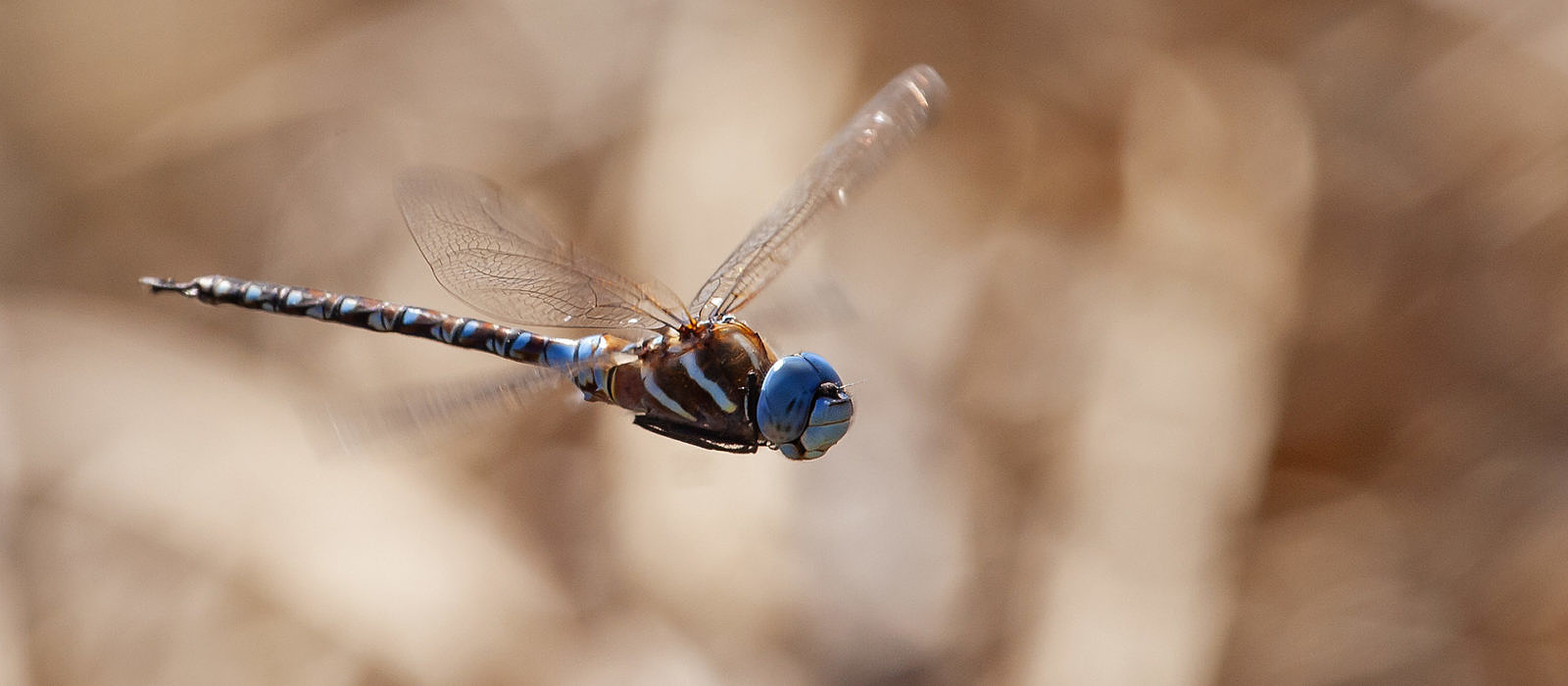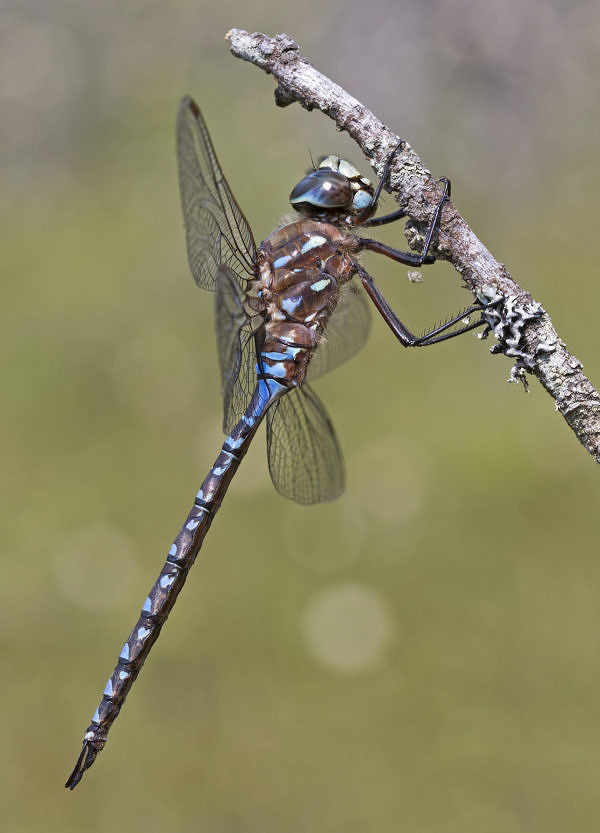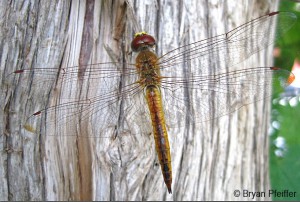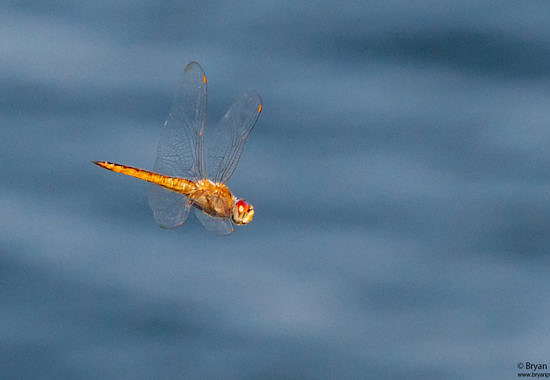
Dragonfly Swarms
Airborne Mobs on the Hunt or in Migration
Updated September 3, 2019
They swarm at mountain summits, along dirt roads, in back yards and over meadows. They flash pastel blues, carmine reds and sacred golds. And for the most part, they’re doing what dragonflies do: fly around, kill things and have sex. Some are migrating.
Many of these dragonfly swarms represent a localized rite of summer, which is prime-time for flights of the large “Mosaic Darners” in the genus Aeshna. These impressive dragonflies are big and marked in blues, greens and yellows. And most aren’t migrating — they’re killing.

Variable Darner (Aeshna interrupta)
North America has 15 members of this genus, all of which can be identified by the shape of the two stripes on the thorax (the thick segment where the wings and legs are attached). Note, for example this Variable Darner (Aeshna interrupta) at a bog in Vermont on 17 Aug 2012. Those broken blue side stripes are diagnostic here in the East. Compare it to the Blue-eyed Darner (Rionaeschna multicolor) on the wing above, which I photographed in Arizona on 8 April 2010.
Swarm Foraging
All dragonflies mature, from egg to growing nymph, in water: rivers, lakes, ponds or wetlands (even roadside ditches). Aeshna, most abundant at lakes and ponds, can undergo a mass emergence from their natal waters to fly as adults in big numbers. If they’re not having sex, dragonflies spend a good portion of their day flying around and killing things. So much of what you’re seeing in summer or fall amounts to swarm-feeding or swarm-foraging.
Swarms form around prey species, often small flies. On the wing, the dragonflies patrol, nab a flying insect, dispatch it with a swift bite and most often land somewhere to finish its meal; sometimes they eat on the wing. In these feeding swarms, dragonflies can track and follow aggregations of prey species as they shift in location and abundance.
Some dragonflies, it seems, can even locate food using past experience and topographical clues. One researcher in Costa Rica (Young 1980) noticed Roseate Skimmer (Orthemis ferruginea) gathering in good numbers to feed over trays of black-pepper berries fermenting and drying in the sun. The skimmers were feeding on fruit flies and other insects attracted to the berries. When the trays were removed, the Roseate Skimmers departed post haste. But when empty trays were returned to the site, the skimmers returned to investigate, apparently keying on the visual clue as a source for food.
Other causes for swarm formation include dragonflies and their prey gathering in the lee of an otherwise windy setting, for example, or in a sun-dappled clearing in the woods where evening light makes prey easier to locate (Corbet 1999).
Migration
August and September, at least here in the East, is also prime time for an amazing dragonfly called Wandering Glider (Pantala flavescens). About three inches long, Pantala is the color of gold and a flying machine. It is found on every continent except Antarctica. Its long, wide wings allow this dragonfly to cross oceans, making Pantala a champion flier among dragonflies, in many respect the albatross of insects.
It is also steeped in mythology. Pantala, for example, is a symbol of courage and victory in Japan. Large numbers appear in Honshu (the nation’s main island) and Kyushu (the third largest island) around August 15, a date on which Buddhists believe ancestral spirits visit their homes.
On August 13, 2009, Wandering Glidersinvaded Montpelier, Vermont (where I live and have an office), probably numbering in the thousands. Exactly one year later, on August 13, 2010, they came again. They cruised the intersection of State and Main. They hovered in the parking lot of the Shaw’s grocery store. And they patrolled in front of the Vermont Statehouse. Few people noticed the Wandering Gliders that day, at least until I went downtown with a net and started swinging. I’ve often seen them in mid August in years since (including now in 2019).
We tend to see dragonfly migration mostly in the fall. In fact, birders often notice migrating dragonflies from hawkwatch sites. One of my best encounters came while birding on Monhegan Island, off Maine’s midcoast, in September of 2009. It was a river of dragonflies, almost entirely Common Green Darners (Anax junius) heading out to sea, southbound for who knows where.
But we’re learning. Researchers have attached tiny radio transmitters to Anax junius and other migratory dragonfly species in order to track their movements (Wikelski 2006). Others can catch a migrating dragonfly in, say, New Jersey, and by measuring trace concentrations of certain atoms (stable isotopes) in its tissue can learn about where it grew up. This is a very cool line of wildlife research with huge potential, something I cover in detail in a post called Going Nuclear for Dragonflies.
Although about 16 of the 326 or so dragonfly species in the U.S. migrate in one way or another, we’re tracking the movements of five classic migrants. Learn about that at the Migratory Dragonfly Partnership. Or check out news of the multi-generational migration of Common Green Darners (Anax junius), covering more than 600 km (373 miles) on average, with some individuals flying more than 2,500 km (1,553 miles).
Finally, see a swarm for yourself in my video from Michigan on July 24, 2010.
 Common Green Darner (Anax junius)
Common Green Darner (Anax junius)
References
Corbet, P.S. (1999). Dragonflies: Behaviour and ecology of Odonata. Essex, Harley Books, 829p.
Wikelski, M., Moskowitz, D., Adelman, J. S., Cochran, J., Wilcove, D.S., and May, M.L. (2006) Simple rules guide dragonfly migration. Biol. Lett. (2006) 2, 325–329
Young, A.M., (1980). Observations on feeding aggregations of Orthemis ferruginea(Fabricus) in Costa Rica (Anisoptera: Libellulidae). Odonatologica 9:325-328.



I’m in Villa Ridghe Mo. 40 miles west of the St.Louis metro, 3 miles south of the 251 mile marker on Interstate 44.
They do “wander!” 🙂 Where’s Villa Ridge?
We had hundreds of Wandering Gliders on our pond for several days in Villa ridge, and now they are gone.
We have had swarms of dragonflies here, near st louis, mo, for two days now. It’s incredible to watch them! They just keep circling! Two days now, just circling! We have had a lot of flooding lately, so that may be part of it.
Been in Southeast Texas since 1992 and have never seen the vast number of blue thorax swarmers before. They seem to be quite high 20-30 feet in addition to house level. Had heavy rains here for past few weeks, some but not unusual mosquito activity, probably heavier in the adjacent swamps….
I have had for the past 2 months, what look like baby dragonflies, flying around here. There is no water, no bugs, nothing that I can think of for them to be here. I’ve lived here for over 2 years, in the spot, and one never seen them before, until now. I’m not seeing them “hook up” and there are not any bugs for them to eat. It is all concrete and cars where they are with some trees and little grass. I haven’t seen not even one land. Can someone explain this one too me. I’m a forth generation Florida woman and never seen this before. Thank you in advance.
I am watching for them here in Maine. The last two years they did their massive ballet on August 15th for just one evening at sundown. So far, I’ve only seen one at a time once in awhile this summer (not every day).
Hi Bryan, have had a swarm in my yard Here in Brookfield at dusk the last couple of nights. Never witnessed this phenomenon before. Very cool. Love your stuff. Glenn
My yard in southern california is swarming now. We have no water or mosquitoes in abundance. Just a senior living area. I have been around here for 78 years and never seen anything like it.
Thanks, Owen. One thing I like about this migration is that it can surprise you. Never know where these insects might turn up!
Yes, at first I thought they were hummingbirds, which would be unusual for so many in our area.
I’m inquiring because at our dog park which is next to a large retention lake I noticed that over a week or more large swarms of dragonflies. Thought maybe they were mating as they were about for such a long time. This is in Central Florida not far from the Gulf. I love seeing them but didn’t know what they were up to. I could see them farther away from the lake, across the street swarming near houses, later around the open fields surrounding the lake. So very cool.
If anyone can suggest digital camera settings that might work to catch dragonflies in flight in pre-dusk lighting, I’d love to know what might work for next time. (I’m still learning with my Canon PowerShot that has some manual setting choices). I’ll try to read up on it before their Aug 15th, 2020 reappearance.
Sooner or later, I’ll write about that radar — it’s an incredible tool.
Oh, yes — by all means. These “prey swarms” can be thick and thousands of tiny flies or other insects. A feast for the dragonflies!
Lots of wonderful stuff flying around the Panhandle, Kris. I was there in late March (still winter up here then). It was a delight!
Perhaps waves of migrants, perhaps a local event. Hard to say. But even a lousy photo might help solve that mystery. (I recognized that it’s tough to photography dragonflies in flight. 🙂 )
I’m getting some other nice reports from Virginia!
Hi Ed. I suspect you’ll have them flying well into October!
Thanks for the report, Marcia. Even a lousy photo might help ID them. 🙂
I hope it means a good winter, Lee. And, yes, I suspect they’re feeding on your small flying insects.
Just seen a huge swarm of dragonflies in our yard. I would say about 100 in all between our yard and the neighbors. We have had issues with knats, and mosquitoes this year so hope they are enjoying them. My husband nor myself have ever seen these many together at one time. Its almost an earie type of thing. Makes us wonder if its a bad winter heading our way this winter. We live in Blountville TN and this is a 1st for us. We are lucky to see one during the spring or summer months unless we are out at the lake fishing.
We live in Mineral Va and this evening there were 100s dragonflies in our yard they stay about a hour or more
Hundreds and hundreds of swarming dragonflies at our place in Smyth County in SW Va. Never had them before. We have had a bad season for no-see-um biting gnats or flies so I am hoping they are feasting on them! Interesting all the other reports…..
We have a swarm in our yard in Botetourt, Virginia. We’ve never seen dragonflies in our yard, much less a swarm. It’s incredible.
I live in Pennsylvania and there were 100s of dragonflies around my house right before dusk yesterday 1st time I had seen so many. They weren’t all flying together tho but they did come from the same direction and then they were everywhere and seemed to be going in all directions then all flew away toward the north. About 30 minutes later same thing happened.
Today we had numerous large dragonflies flying over our deck near the house. This lasted for about an hour. From the kitchen, they looked like hummingbirds, so we went out and saw they were dragonflies. We could even hear a buzz. We live in the Eastern Panhandle.
I was amazed by the amount of other bugs that the small amount of dragonflies were going after. They almost looked like dust particles floating in the air or small, steady snowflakes. Is it possible there are that many insects in the lawns that the dragonflies stirred up or do they somehow accompany them in the swarm. I only had about 10 dragonflies flying around in my yard.
I live in NE Ohio and noticed dragonflies and other bugs flying around my yard today. The news reported a swarm that showed up on the weather radar. I wanted to find out more about what was going on and I found your website. Thanks for the information about the dragonfly swarms.
A classic swarm. It sounds impressive, Ellen. Probably migrants. And many of them probably Common Green Darners and various “mosaic darners” in the Genus Aeshna. Thanks for the report!
A lovely Common Green Darner — one of our most widespread and wandering dragonflies. Thanks, Amanda!
Here are pictures and video i took in Missouri last night.
https://www.instagram.com/p/B1uiS1Rg_Ej/?igshid=itt5vxrf1skv
I live on a farm in SE Nebraska. This evening about 7:30 I looked outside and saw what had to be thousands of dragonflies swooping around. I have never seen so many at once. Some were quite large and my grand kids thought they saw blue and green – I couldn’t tell. They tried catching some but they never landed and we didn’t have a net. We have a pond close by and have had lots of rain this summer, esp. during August. They slowly disappeared during dusk. Amazing.
Hi Pam, Do these seem to be darners — marked in pastel blues, greens and yellows? Or maybe Wandering Gliders, mostly golden?
For the past two early evenings, my yard has been full of dragonflies. I live in Idaho and we don’t see so many in this ara. I called nearby neighbors, but no one seems to see any except me and a visitor who was here. It was mesmerizing! Not much water here [desert near Snake River Canyon], so I am hoping they are here for the nightly gnat buffet.
Thanks for the report, Ellen. Yes, indeed, that “choreographed ballet” you mention so eloquently is in large part solar-powered. They do their best in sunshine. But migrants or hunting swarms do take flight on warm, muggy overcast days as well. (I’ll take ’em rain or shine!)
They came back in large numbers to do their choreographed ballet in my open backyard in the woods in Raymond, ME yesterday. It’s the second year I’ve noticed them. Last year they were a few days earlier, so I’d been watching for them. Could overcast weather this year account for the few days delay? (Both appearances have been on very sunny days.) They put on the loveliest show!
I saw what people on the NE Odonata FB page figured were wandering gliders, laying eggs on car hoods at the New England antique car auction at Owls Head Transportation Museum last week. I couldn’t believe they were doing that– I got some photos but none were very detailed, and the videos showed what they were doing but still didn’t catch much detail but the color was right and it seemed like there were hundreds around.
Thank you. I live about 50 miles off the coast in S.E. NC and saw a bunch of them swarming above my house. I really don’t mind having them around if they eat other insects. Good photography material too!